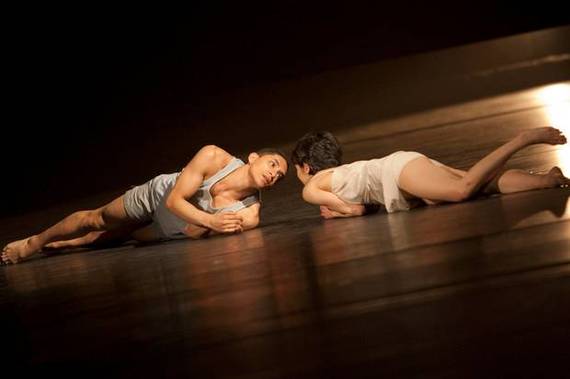What's in a name? In the case of Mats Ek's Juliet & Romeo, which Royal Swedish Ballet presented last week at Sadler's Wells, the switched-up name is just the first of many nuances that make a poignant case for this new version of an old classic.
For starters, Ek dispenses with the familiar Prokofiev score in favor of Tchaikovsky's, which he abridges and reconfigures. The editing is choppy at times, but overall the more lyrical quality of Tchaikovsky's score provides an effective counterpoint to the production's jagged edges.
In a program note, Ek explains that his ballet was inspired by events that triggered the Arab Spring, but it isn't set in a particular time or place. Costumes pay vague tribute to the story's Renaissance origins, but also include jeans, hoodies and sparkly muscle shirts. With shady lighting and shifting walls of corrugated metal, the set invokes a fearful and brutal atmosphere that could belong to any era.
Combining classical, contemporary and pedestrian movement, the choreography is either gorgeously fluid or uncomfortably awkward, but always by careful design. Ensemble pieces are aggressive, yet precise -- the individual dancers acting as cogs in a violent political machine.
Meanwhile, individual characters are drawn in painstaking, quirky detail. The Prince (Jan-Erik Wikström) is an ineffectual figurehead, rolling like tumbleweed through a desert between militant drills of grand battement. Lord and Lady Capulet (Andrey Leonovitch and Gina Tse) are unflinchingly cold and controlling, with temperamental Tybalt (Vahe Martirosyan) following closely in their footsteps. Jens Rosén's Benvolio is goofy and good-natured, while Luca Vetere portrays volatile Mercutio with all the intensity of a silent-film actor.
There is no Friar Laurence in this version; instead, it is the nurse (Jenny Nilson) who acts as the ballet's moral compass. A far cry from the helpless, comic character from traditional versions, she embodies maternal love and protectiveness -- towards Juliet, above all, but also towards Romeo and his friends in the second act.
As for the title characters, Romeo (Anton Valdbauer) is a romantic dreamer, if a bit of a ninny, and Juliet (Rena Narumi) is still more girl than woman. The chemistry between them is unconvincing, which proves a disappointment in the balcony and bedroom duets. Despite some lovely moments -- soaring, ecstatic lifts punctuating low, instinctive movements -- the choreography ultimately relies too heavily on thrusting pelvises, splayed legs and contrived giddiness to make its point.
But much to my surprise, the weak chemistry between the central characters did little to dampen the story's impact. For in Ek's interpretation, love-at-first-sight and magic potions are romantic fantasies that distract from a much harsher reality.
In his version, Juliet is a child bride who is auctioned off like a horse to a sneering Paris. Her brief romance with Romeo represents not necessarily the love of a lifetime, but a first crush on the passage into adulthood. And when the young lovers meet their tragic fate, it's not the result of a well-intended plot gone wrong (Ek dismisses the idea of a temporary death as ridiculous). Instead, it's a murder in cold blood.
The storytelling isn't perfect. Zealous as Tybalt is, he appears to kill Mercutio by accident. Romeo's slaying of Tybalt is even harder to believe: as he springs back and forth over Tybalt's body, the effect is more Footloose than Fight Club.
Overall, though, Ek's stripped-down, switched-up version of the story strikes a relevant, if uncomfortable chord. Its beauty lies in its stark truthfulness, even if, as Ek is fond of saying, beauty isn't always pretty.

